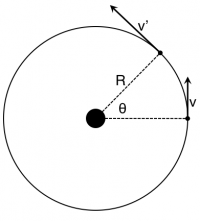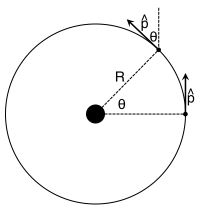This is an old revision of the document!
Modeling Curved Motion
The motion of objects is not limited to straight line motion. As you read earlier, forces can change the momentum of objects (including the direction of that momentum). These interactions can produce projectile motion, circular motion, oscillations, or more generalized trajectories. In these notes, you will read about how to model more generalized motion using the momentum principle.
The Derivative form of the Momentum Principle
Earlier, you read about the momentum principle, and how interactions with a system's surroundings can change the momentum of a system. This principle was stated as a macroscopic change $\Delta \vec{p} = \vec{F}_{net} \Delta t$. That is, the time change is some reasonably measurable amount. However, when we considered very short time intervals, so short that the momentum could be changing all the time, we found that this principle was transformed to the derivative form 1).
$$\dfrac{d\vec{p}}{dt} = \vec{F}_{net}$$
As you've read, any vector can be written as the product of its magnitude and unit vector. In particular, you can write the momentum vector in this way,
$$\vec{p} = |\vec{p}|\hat{p}$$
If you plug this into the derivative form of the momentum principle, you can then take the derivative of each piece of the product. This mathematical operation is called the "Chain rule."
$$\vec{F}_{net} = \dfrac{d\vec{p}}{dt} = \dfrac{d|\vec{p}|}{dt}\hat{p} + |\vec{p}|\dfrac{d\hat{p}}{dt}$$
Evidently, you can rewrite the momentum principle as the sum of two parts: a part that points along the direction of the momentum (the $\hat{p}$ part) and another part that points in the direction that the momentum is changing (the ${d\hat{p}}/{dt}$ part).
A change in speed
The first half of the momentum change describes how the magnitude of the momentum changes (${d|\vec{p}|}/{dt}$). This vector will point in the direction of the momentum vector if ${d|\vec{p}|}/{dt} > 0$ and opposite the direction of the momentum vector if ${d|\vec{p}|}/{dt} < 0$. If the momentum is not changing (${d|\vec{p}|}/{dt} = 0$), then this vector is zero.
This sign and size of this vector tells you how the speed of the object is changing. Is it speeding up (${d|\vec{p}|}/{dt} > 0$)? Slowing down (${d|\vec{p}|}/{dt} < 0$)? Or moving at constant speed (${d|\vec{p}|}/{dt} = 0$)?
The change in the magnitude of the momentum is the result of the component of the net force that is parallel to the direction of motion (momentum). This component is referred to as “F net parallel” or $\vec{F}_{net,\parallel}$. Some also call this force the “tangential component of the net force”; it is always tangent to the trajectory of the object. So, we have a relationship between this force component and the change in the magnitude of the momentum.
$$\vec{F}_{net,\parallel} = \dfrac{d|\vec{p}|}{dt}\hat{p}$$
A change in direction
The second half of the momentum change describes how the direction of the momentum is changing (${d\hat{p}}/dt$). This vector will point in the direction that the momentum is changing. This direction is always perpendicular to the tangent of the path, and pointing in the direction of the turn. Let's see how that's the case.
Consider a car driving on a circular track that is speeding up.

